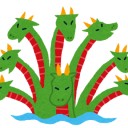神河当時 - 「神の乱/Kami War」の経緯
2020年8月13日 Magic: The Gathering
昨日の記事の続きです。
マローが言う「制限は創造の母」の通り、神河において、著者はいくつかの制限を考えました。
1 他に類を見ない、日本的な設定
2 日本の文化を尊重し、固定観念に囚われない
3 常に5色と悪役クリーチャーの必要性を念頭に置いて、マジックに忠実であること
また、Bill Roseは「日本にインスパイアされたものである」という制限も設けたそうです。
日本の土着の宗教・神道においては、あらゆるものには神が宿ります。民話に百足や竜のような怪物が出たときも、それらは神とも呼ばれます。そうしたことから、神河における悪役が神に決まりました。
神を悪役として戦う、ということから、「間違った神道」というコンセプトが誕生しました。これが1や2の制限を満たします。
また、欧米人への親しみやすさから、神と戦う人々としてサムライなどが登場することになりました。
これが、「神の乱/Kami War」という『神河物語』ブロックの根本設定が生れたいきさつです。
「神の乱」は、上記の制約から生まれたものです。ということは、神河に再訪する際、同様に制約を設ければ、同様のストーリーになるのでしょうか。
しかし、神河は神と住民が戦うのが当たり前の次元ではありません。「神の乱」はあくまでもイレギュラーな事態です。とは言っても、登場するたびに神と戦っていては、そういう次元という印象になるでしょう。
上記のような制約を満たしつつも、従来とは違ったストーリーとはどのようなものか、色々想像してみています。
2021/03/09 追記
日本語訳を見つけました。
一連の幸運:神河世界のデザイン――神河の巨大な世界の創造
https://web.archive.org/web/20041113050558/http://www.hobbyjapan.co.jp/magic/articles/files/20041025_01.html
Rosewater’s Mantra
If you’ve read, say, two of Mark’s columns, you know that he believes that restrictions aid creativity. I think this is correct (most of the time), and it was definitely true with Kamigawa design. The first restriction came from Bill: This setting had to be Japan-inspired. The next batch of restrictions came from me: (1) Do a Japanese setting unlike any other. (2) Be respectful of Japanese culture by doing your homework and avoiding stereotypes. (3) Stay true to Magic by always keeping the five colors and the need for badass creatures in sight.
As I read more and more Japanese folklore, some patterns began to emerge. The first was transformation—things that seemed like one thing but were actually another, or things that actually became other things. As Mark wrote in “Flipping Out,” this theme would become the basis for the “night/day” mechanic, and would eventually end up on the “hero” cards.
This pattern dovetailed nicely with another one: In Shinto, the indigenous religion of Japan, everything has a divine essence, a kami. And often, when a monster such as a giant centipede or a humungous underground catfish (yes, really) or a dragon appeared in folk tales, it was referred to as a divinity, a kami. This would become the answer to our creature problem. The bizarre, badass creatures of Kamigawa wouldn’t just be monsters. They would be divinities of all shapes, sizes, and colors. They would be gods.
So a kind of accident led to the solution of multiple problems. If kami are the creatures of this world, why are they fighting? This question led to the “Shinto gone wrong” concept, which is the feature of Kamigawa that separates us from all other Japan-inspired settings. But what about the familiarity goal that started us on this path in the first place? That’s why we would also include all the elements of medieval Japan with which Western players are familiar: samurai, katana, ryuu/tatsu (dragons), and so on. And with bizarre kami on one hand and feudal Japanese social roles on the other, the Kami War was born.
引用元
A SERIES OF FORTUNATE EVENTS: KAMIGAWA WORLD DESIGN Posted in Feature on October 18, 2004
https://magic.wizards.com/en/articles/archive/feature/series-fortunate-events-kamigawa-world-design-2004-10-18
マローが言う「制限は創造の母」の通り、神河において、著者はいくつかの制限を考えました。
1 他に類を見ない、日本的な設定
2 日本の文化を尊重し、固定観念に囚われない
3 常に5色と悪役クリーチャーの必要性を念頭に置いて、マジックに忠実であること
また、Bill Roseは「日本にインスパイアされたものである」という制限も設けたそうです。
日本の土着の宗教・神道においては、あらゆるものには神が宿ります。民話に百足や竜のような怪物が出たときも、それらは神とも呼ばれます。そうしたことから、神河における悪役が神に決まりました。
神を悪役として戦う、ということから、「間違った神道」というコンセプトが誕生しました。これが1や2の制限を満たします。
また、欧米人への親しみやすさから、神と戦う人々としてサムライなどが登場することになりました。
これが、「神の乱/Kami War」という『神河物語』ブロックの根本設定が生れたいきさつです。
「神の乱」は、上記の制約から生まれたものです。ということは、神河に再訪する際、同様に制約を設ければ、同様のストーリーになるのでしょうか。
しかし、神河は神と住民が戦うのが当たり前の次元ではありません。「神の乱」はあくまでもイレギュラーな事態です。とは言っても、登場するたびに神と戦っていては、そういう次元という印象になるでしょう。
上記のような制約を満たしつつも、従来とは違ったストーリーとはどのようなものか、色々想像してみています。
2021/03/09 追記
日本語訳を見つけました。
一連の幸運:神河世界のデザイン――神河の巨大な世界の創造
https://web.archive.org/web/20041113050558/http://www.hobbyjapan.co.jp/magic/articles/files/20041025_01.html


コメント